![]()
![]()
![]()
Use LEFT and RIGHT arrow keys to navigate between flashcards;
Use UP and DOWN arrow keys to flip the card;
H to show hint;
A reads text to speech;
10 Cards in this Set
- Front
- Back
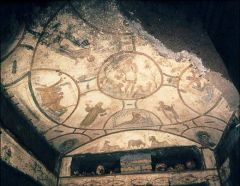
|
Ceiling from the Catacomb of Sts. Peter and Marcellinus
Early Christian Rome Christians were being prosecuted, so they were all like "lets hide in our private homes and pray" Persecution ended with the Edict of Milan under Constantine. Catacomb was a place to bury dead away from pagans. vast underground network and in some places five levels deep. more than four million bodies. rejected cremation. Frescoes painted on the ceilings poor quality because of the difficult conditions (dark, damp, smelly) Roman in style; Christian in subject |
|
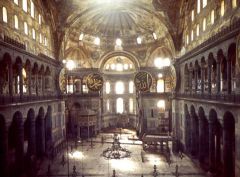
|
Hagia Sophia
Byzantine Constantinople Constantine moved the capital to Constantinople, dividing the empire into east and west The western portion weakened and fell into the middle ages (Early Christian). The eastern portion became Byzantine Empire, later taken over by the Ottoman Empire. Many people the fled back to western Europe, which became one of the sparks for the Renaissance. Vertical emphasis to draw the eye up toward heaven Plain outside and beautiful inside represents Christian soul with plain body and beautiful spirit Served as a church, then a mosque, then museum Large central dome with pendentive, triangular construction that redistributes weight to allow for a round dome on a square building Halo of light, makes the dome seem to float Commissioned by Emperor Justinian 40 arched windows at the base of the dome, light to represent spirituality |
|
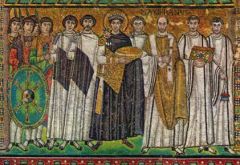
|
Justinian and His Attendants
Byzantine San Vitale Ravenna, Italy Mosaic, colored glass Justinian, church and state Three groups: army, clergy, followers Halo represents divine status Symbolic hierarchy shown by the feet overlaping Carries bread for communion (wife in opposite mosaic carries wine) Tall, slim figures with flat bodies creates coat hanger effect. lack of body form, spiritual rather than earthly (the body of the church) |
|
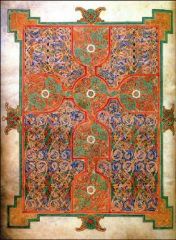
|
Ornamental Page, Lindisfarne Gospel
Hiberno-Saxon c. 700 Illuminated manuscripts Only form of books until the printing press Texts and paintings copied by monks and nuns Usually religious texts like bibles and prayer books Elaborate decoration to honor how sacred the contents were Interlace is a complex pattern of woven lines (serpentine/animal forms included) created lively, energetic effect Sometimes called “carpet pages” because they resemble oriental rugs Hiberno-Saxon means English and Irish isles |
|

|
Animal Head
Viking The Osberg Ship Burial Vikings terrorized the coastal areas of western Europe using fear as a tactic The Animal Head is a wood carving, bow of a ship or carried in parade this is what the people being invaded would see first. Fierce-looking and terrifying Interlace pattern is carved into the wood. |
|
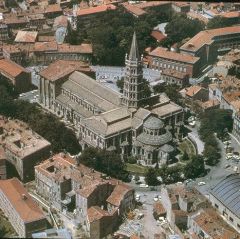
|
St. Sernin
Romanesque Toulouse, France Romanesque Roman-like began as a derogatory term, describing the Roman rounded arch Wave of church building became status symbol for a town Pilgrimages, see sacred relics, salvation Spread ideas and money Built out of stone to prevent fires massive walls, plain exterior Nave/apse and transept create cross shape Interiors feel very dark, small windows |
|
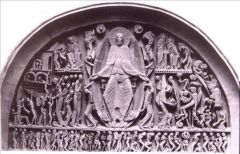
|
Last Judgment
West Tympanum of St. Lazare Romanesque Autun, France Tympanum is area ]in the rounded arch just above my chamber door Stories in stone to instruct the largely illiterate population about the church; meant to teach by scaring Figures were stylized, flat, and linear Message was pessimistic, focussed on sins Christ at the center as judge saved on one side and damned on the other people waiting to weigh the souls Shows medieval imagination created by Gislebertus |
|
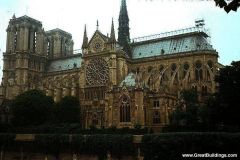
|
Notre Dame
Gothic Paris, France Gothic originated in France Flying buttress for exterior support Stained glass showed stories of the Bible, which were used to teach the illiterate and made the church look beautiful Pointed arch Inside is lighter and more open Vertical emphasis Race to tallest church, until one collapsed at 157 feet high Building was a community effort |
|
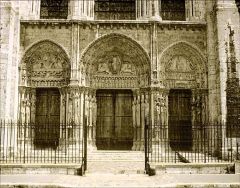
|
Royal Portal of Chartres Cathedral
Gothic Chartres, France Message was more optimistic than Romanesque Jamb statues - the kings and queens of France Royal lineage is the divine right to rule because they are descendents from saints Subject - second coming of Christ |
|

|
The Annunciation and Visitation
Reims Cathedral Gothic Reims, France Greater interest in accomplishments and role of men more realistic looking Annunciation, the angel coming to Mary to inform her of her future child Jesus Visitation - between Mary and Elizabeth Gothic S-curve – modified contrapposto, body in an S-shape; not a natural position, but looked elegant |

